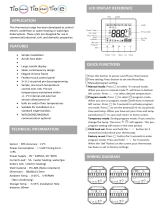
16
Outdoor Unit Inverter:
WARNING
ELECTRIC SHOCK HAZARD!
Disconnect power before servicing the outdoor
unit. Failure to follow these instructions may
result in electric shock or death. Trouble-
shooting the outdoor unit may require that
power be restored with the control panel
cover removed. Become familiar with the
control panel and hazardous voltage areas
before proceeding.
Time is required for inverter voltage to bleed
down after removal of line power. Wait at least
60 seconds after removing line voltage before
touching any inverter parts or wiring.
Normal – Examine the following with the control panel cover
off. Note the two smaller circuit boards mounted on a metal
“bridge” over the inverter. The red LED behind the upper
right side of the bridge should be lit and on steady when
power is applied to the inverter. Refer to Figures 2 and 12.
Abnormal –The red LED behind the upper right side of the
bridge is not lit. In this case, power is not being provided to
the inverter. Check that line voltage is being applied to the
bottom of the contactor. If so, check that 24 vac is being
provided across the contactor coil. If not, check the control
power wiring (RED and GRY wires) for 24 vac. Check that
the high pressure switch is closed. A fault indicating OD
UNIT COMM FAULT or OD UNIT LOST POWER would also
result from no line voltage applied.
The red LED behind the upper right side of the bridge is
lit but blinking. This indicates that the inverter is powered
up and that it detects a fault condition. If the controller
does not display a fault message, put the unit into HEAT or
COOL mode, and a message will be displayed. Note that
when line power is removed, this LED will blink for about 1
minute before going out. Check that the 3- and 4-position
communication plugs are connected to the terminals marked
“INVERTER” and “INDOOR” on the right side of the outdoor
interface board.
Outdoor Unit Interface Board (right side small circuit
board):
Normal – Refer to Figure 13. The red LED at the upper
left of this board should do a “heartbeat” blink, consisting
of a double-blink followed by a pause, repeated. Note 4
other LEDS towards the lower edge of the board. When
the compressor is off, the 3rd LED from the right should be
on (crankcase heater). When the compressor is running
in heating, the 2nd LED from the right should be on (EXV
enabled to open). When the unit is heating and in a defrost
cycle, the 1st and 4th LEDs from the right should be on.
When the compressor is running in cooling, the right-most
LED should be on (reversing valve is energized).
Abnormal – If no LEDs are lit on the board, 24 vac control
power is not being provided across the “R” and “C” terminals.
Check for this voltage between the left-most two screw
terminals (labeled R and C).
Outdoor Unit EXV Board (left side small circuit board):
Normal – Refer to Figure 14. The green LED at the upper left
of this board should be steadily on, except that a blink at a
regular rate can be expected during cooling operation.
Abnormal – If the green LED is not lit, the EXV board is
not getting 24 vac power from the interface board next to it.
Check for 24 vac between R and C on the interface board,
and check that the tabs marked “R” and “C” on the interface
board are wired to “R” and “C” on the EXV board (red and
gray wires, respectively). These should not be cross-wired.
If the green LED is blinking at a regular rate during heat
pump heating, it indicates that one of the two EXV sensors
is reading out of range. Refer to training literature for sensor
interpretation and troubleshooting.
If the green LED is blinking at a non-uniform rate (heartbeat),
it indicates that the board has been placed in the Manual
Mode. Hold down the small black button on the board for
more than 3 seconds to return it to automatic control mode.
Indoor Unit Interface Board (in G6 iQ furnace kit or air
handler)
Normal – The red LED at the upper left of this board should
do a “heartbeat” blink, consisting of a double-blink followed
by a pause, repeated. Note 4 other LEDS towards the lower
edge of the board. When the equipment is off, none of the
LEDs should be on. If the furnace or electric strip heat is
on, 3rd LED or 3rd and 4th LEDs from the right should be
on (fi rst and second stage auxiliary heat). When the unit is
cooling the right-most LED should be on (EXV enabled to
open). If humidifi cation is called for, the 2nd LED from the
right should be on.
Abnormal – If no LEDs are lit on the board, 24 vac control
power is not being provided across the “R” and “C” terminals.
Check for this voltage between the left-most two screw
terminals (labeled R and C).
Indoor Unit EXV Board:
Normal – The green LED at the upper left of this board
should be steadily on, except that a blink at a regular rate
can be expected during heat pump heating operation.
Abnormal – If the green LED is not lit, the EXV board is not
getting 24 vac power from the interface board. Check for
24 vac between R and C on the interface board, and check
that the tabs marked “R” and “C” on the interface board are
wired to “R” and “C” on the EXV board. These should not be
cross-wired.




















